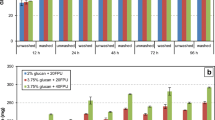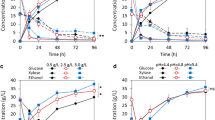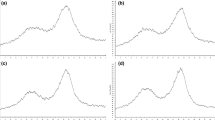Abstract
This study investigates a fed-batch simultaneous saccharification fermentation (F-SSF) process to increase ethanol titres from highly lignified (41.6 wt.%) cotton gin trash residue. The optimal initial solid loading, enzyme dose, feed quantities and intervals to maximize substrate feed and subsequent ethanol titres were examined. Under batch SSF conditions, initial extracted cotton gin trash (ECGT) solid loadings were maximised at 19.35 wt.% and attained an ethanol titre of 23.3 g/l with a corresponding yield of 53.7%. Operating under optimised F-SSF mode, fermentations were initiated with 16.13 wt% EGCT solids followed by fresh ECGT feeds of 16.13 wt% and 12.9 wt.% at 12-h intervals. Cellulase levels were maintained at 44 FPU/g glucan throughout the fermentations. The final ethanol titre of 41 .4 g/l with a corresponding conversion rate of 70.1% was achieved after 72 h. Comparable ethanol yields of 40 g/l with 67.8% conversion were realized with lower cellulase dosing (25 FPU g/glucan) but only after extending the fermentation by 24 h.






Similar content being viewed by others
References
Guo MX, Song WP (2019) The growing US bioeconomy: drivers, development and constraints. New Biotechnol 49:48–57
Hudiburg TW, Wang W, Khanna M, Long SP, Dwivedi P, Parton WJ, Hartman M, DeLucia EH (2016) Impacts of a 32-billion-gallon bioenergy landscape on land and fossil fuel use in the US. Nat Energy 1:15005
Alvira P, Tomás-Pejó E, Ballesteros M, Negro MJ (2010) Pretreatment technologies for an efficient bioethanol production process based on enzymatic hydrolysis: a review. Bioresour Technol 101(13):4851–4861
Wyman CE (2007) What is (and is not) vital to advancing cellulosic ethanol. Trends Biotechnol 25(4):153–157
Paulova L, Patakova P, Branska B, Rychtera M, Melzoch K (2015) Lignocellulosic ethanol: technology design and its impact on process efficiency. Biotechnol Adv 33(6, Part 2):1091–1107
Wingren A, Galbe M, Zacchi G (2003) Techno-economic evaluation of producing ethanol from softwood: comparison of SSF and SHF and identification of bottlenecks. Biotechnol Prog 19(4):1109–1117
Larsen J, Petersen MO, Thirup L, Li HW, Iversen FK (2008) The IBUS process - lignocellulosic bioethanol close to a commercial reality. Chem Eng Technol 31:765–772
Fan Z, South C, Lyford K, Munsie J, van Walsum P, Lynd LR (2003) Conversion of paper sludge to ethanol in a semicontinuous solids-fed reactor. Bioprocess Biosyst Eng 26(2):93–101
De Bari I, Viola E, Barisano D, Cardinale M, Nanna F, Zimbardi F, Cardinale G, Braccio G (2002) Ethanol production at flask and pilot scale from concentrated slurries of steam-exploded Aspen. Ind Eng Chem Res 41(7):1745–1753
Liu Z-H, Qin L, Zhu J-Q, Li B-Z, Yuan Y-J (2014) Simultaneous saccharification and fermentation of steam-exploded corn stover at high glucan loading and high temperature. Biotechnol Biofuels 7(1):1–16
Modenbach AA, Nokes SE (2013) Enzymatic hydrolysis of biomass at high-solids loadings – a review. Biomass Bioenergy 56:526–544
Kristensen J, Felby C, Jørgensen H (2009) Yield-determining factors in high-solids enzymatic hydrolysis of lignocellulose. Biotechnol Biofuels 2(1):1–10
Koppram R, Tomás-Pejó E, Xiros C, Olsson L (2014) Lignocellulosic ethanol production at high-gravity: challenges and perspectives. Trends Biotechnol 32(1):46–53
Jørgensen H, Pinelo M (2017) Enzyme recycling in lignocellulosic biorefineries. Biofuels Bioprod Biorefin 11(1):150–167
Maeda RN, Barcelos CA, Anna LMMS, Pereira N (2013) Cellulase production by Penicillium funiculosum and its application in the hydrolysis of sugar cane bagasse for second generation ethanol production by fed batch operation. J Biotechnol 163(1):38–44
Cheng N, Koda K, Tamai Y, Yamamoto Y, Takasuka TE, Uraki Y (2017) Optimization of simultaneous saccharification and fermentation conditions with amphipathic lignin derivatives for concentrated bioethanol production. Bioresour Technol 232:126–132
Zhang T, Zhu M-J (2017) Enhanced bioethanol production by fed-batch simultaneous saccharification and co-fermentation at high solid loading of Fenton reaction and sodium hydroxide sequentially pretreated sugarcane bagasse. Bioresour Technol 229:204–210
Raj K (2019) Improved high solid loading enzymatic hydrolysis of low-temperature aqueous ammonia soaked sugarcane bagasse using laccase-mediator system and high concentration ethanol production. Ind Crop Prod 131:32-40-2019 v.2131
Gao Y, Xu J, Yuan Z, Jiang J, Zhang Z, Li C (2018) Ethanol production from sugarcane bagasse by fed-batch simultaneous saccharification and fermentation at high solids loading. Energy Sci Eng 6(6):810–818
Vancov T, Palmer J, Keen B (2018) A two stage pretreatment process to maximise recovery of sugars from cotton gin trash. Bioresour Technol Rep 4:114–122
McIntosh S, Palmer J, Egbuta M, Liu L, Vancov T (2019) Refining spent cotton gin trash following essential oil extraction for value added cellulosic sugars. Bioresour Technol Rep 7 (in Press)
Chum H, Johnson D, Black S, Overend R (1990) Pretreatment-catalyst effects and the combined severity parameter. Appl Biochem Biotechnol 24-25(1):1–14
Sluiter A, Hames B, Ruiz R, Scarlata C, Sluiter J, Templeton D, Crocker D (2012) Determination of structural carbohydrates and lignin in biomass. NREL Laboratory Analytical Proceedure; NREL/TP-510-42618. Version 08-03-2012. Natl Renew Energy Lab
Chang VS, Holtzapple MT (2000) Fundamental factors affecting biomass enzymatic reactivity. Appl Biochem Biotechnol 84–86
dos Santos AC, Ximenes E, Kim Y, Ladisch MR (2019) Lignin–enzyme interactions in the hydrolysis of lignocellulosic biomass. Trends Biotechnol 37(5):518–531
Weiss ND, Felby C, Thygesen LG (2019) Enzymatic hydrolysis is limited by biomass-water interactions at high-solids: improved performance through substrate modifications. Biotechnol Biofuels 12:3
Cara C, Ruiz E, Oliva JM, Sáez F, Castro E (2008) Conversion of olive tree biomass into fermentable sugars by dilute acid pretreatment and enzymatic saccharification. Bioresour Technol 99(6):1869–1876
Du J, Cao Y, Liu G, Zhao J, Li X, Qu Y (2017) Identifying and overcoming the effect of mass transfer limitation on decreased yield in enzymatic hydrolysis of lignocellulose at high solid concentrations. Bioresour Technol 229:88–95
Vásquez MP, da Silva JNC, de Souza MB, Pereira N (2007) Enzymatic hydrolysis optimization to ethanol production by simultaneous saccharification and fermentation. Appl Biochem Biotechnol 137(1):141–153
Jorgensen H, Vibe-Pedersen J, Larsen J, Felby C (2007) Liquefaction of lignocellulose at high solids concentrations. Biotechnol Bioeng 96:862–870
Romaní A, Garrote G, Parajó JC (2012) Bioethanol production from autohydrolyzed Eucalyptus globulus by simultaneous saccharification and fermentation operating at high solids loading. Fuel 94:305–312
Varga E, Klinke HB, Réczey K, Thomsen AB (2004) High solid simultaneous saccharification and fermentation of wet oxidized corn stover to ethanol. Biotechnol Bioeng 88(5):567–574
Vancov T, Palmer J, Keen B (2019) Two-stage pretreatment process validation for production of ethanol from cotton gin trash. BioEnergy Research (in Press)
McIntosh S, Vancov T, Palmer J, Morris S (2014) Ethanol production from cotton gin trash using optimised dilute acid pretreatment and whole slurry fermentation processes. Bioresour Technol 173:42–51
Jeoh T, Agblevor FA (2001) Characterization and fermentation of steam exploded cotton gin waste. Biomass Bioenergy 21(2):109–120
Sahu S, Pramanik K (2018) Evaluation and optimization of organic acid pretreatment of cotton gin waste for enzymatic hydrolysis and bioethanol production. Appl Biochem Biotechnol 186:1047–1060. https://doi.org/10.1007/s12010-018-2790-7
Fockink DH, Maceno MAC, Ramos LP (2015) Production of cellulosic ethanol from cotton processing residues after pretreatment with dilute sodium hydroxide and enzymatic hydrolysis. Bioresour Technol 187:91–96
McIntosh S, Palmer J, Zhang Z, Doherty WOS, Yazdani SS, Sukumaran RK, Vancov T (2017) Simultaneous saccharification and fermentation of pretreated Eucalyptus grandis under high solids loading. Ind Biotechnol 13(3):131–140
Dimos K, Paschos T, Louloudi A, Kalogiannis K, Lappas A, Papayannakos N, Kekos D, Mamma D (2019) Effect of various pretreatment methods on bioethanol production from cotton stalks, vol 5
Rudolf A, Alkasrawi M, Zacchi G, Liden G (2005) A comparison between batch and fed-batch simultaneous saccharification and fermentation of steam pretreated spruce. Enzym Microb Technol 37
Sassner P, Galbe M, Zacchi G (2006) Bioethanol production based on simultaneous saccharification and fermentation of steam-pretreated Salix at high dry-matter content. Enzym Microb Technol 39
Elliston A, Collins SRA, Wilson DR, Roberts IN, Waldron KW (2013) High concentrations of cellulosic ethanol achieved by fed batch semi simultaneous saccharification and fermentation of waste-paper. Bioresour Technol 134:117–126
Humbird D, Davis R, Tao L, Kinchin C, Hsu D, Aden A (2011) Process design and economics for biochemical conversion of lignocellulosic biomass to ethanol dilute - acid pretreatment and enzymatic hydrolysis of corn stover. Technical Report NREL/TP-5100-47764: 1–147. National Renewable Energy Laboratory, Denver
Robak K, Balcerek M (2018) Review of second generation bioethanol production from residual biomass. Food Technol Biotechnol 56(2):174–187
Berlin A, Gilkes N, Kurabi A, Bura R, Tu M, Kilburn D, Saddler J (2005) Weak lignin-binding enzymes. Appl Biochem Biotechnol 121(1):163–170
Tu M, Chandra RP, Saddler JN (2007) Evaluating the distribution of cellulases and the recycling of free cellulases during the hydrolysis of lignocellulosic substrates. Biotechnol Prog 23(2):398–406
Sassner P, Galbe M, Zacchi G (2008) Techno-economic evaluation of bioethanol production from three different lignocellulosic materials. Biomass Bioenergy 32(5):422–430
Wang Z, Lv Z, YAng X, Tian S (2013) Fed-batch mode optimization of SSF for cellulosic ethnaol production from steam-exploded corn stover. BioResources 8(4):5773–5782
Bauer N, Long C, Karki B, Gibbons W (2014) Increasing ethanol titer and reducing enzyme dosage via fed-batch, simultaneous Saccharification and fermentation in a high solids bioreactor. J Biomass Biofuels 1:38–48
Lee D, Yu AHC, Saddler JN (1995) Evaluation of cellulase recycling strategies for the hydrolysis of lignocellulosic substrates. Biotechnol Bioeng 45(4):328–336
Qi B, Chen X, Su Y, Wan Y (2011) Enzyme adsorption and recycling during hydrolysis of wheat straw lignocellulose. Bioresour Technol 102(3):2881–2889
Lu Y, Yang B, Gregg D, Saddler JN, Mansfield SD (2002) Cellulase adsorption and an evaluation of enzyme recycle during hydrolysis of steam-exploded softwood residues. Appl Biochem Biotechnol 98(1):641–654
Borjesson J, Engqvist M, Sipos B, Tjerneld F (2007) Effect of poly(ethylene glycol) on enzymatic hydrolysis and adsorption of cellulase enzymes to pretreated lignocellulose. Enzym Microb Technol 41(1–2):186–195
Eriksson T, Borjesson J, Tjerneld F (2002) Mechanism of surfactant effect in enzymatic hydrolysis of lignocellulose. Enzym Microb Technol 31:353–364
Kristensen JB, Börjesson J, Bruun MH, Tjerneld F, Jorgensen H (2007) Use of surface active additives in enzymatic hydrolysis of wheat straw lignocellulose. Enzym Microb Technol 40(4):888–895
Tu M, Zhang X, Paice M, MacFarlane P, Saddler JN (2009) The potential of enzyme recycling during the hydrolysis of a mixed softwood feedstock. Bioresour Technol 100(24):6407–6415
Tu M, Chandra RP, Saddler JN (2007) Recycling cellulases during the hydrolysis of steam exploded and ethanol pretreated lodgepole pine. Biotechnol Prog 23(5):1130–1137
Acknowledgements
Financial support was provided by Cotton Research Development Corporation (CRDC) for this work and NSW Department of Primary Industries (NSW DPI) and Southern Cross University (SCU).
Author information
Authors and Affiliations
Corresponding author
Ethics declarations
Conflict of Interest
The authors declare that they have no conflict of interest.
Additional information
Publisher’s Note
Springer Nature remains neutral with regard to jurisdictional claims in published maps and institutional affiliations.
Rights and permissions
About this article
Cite this article
McIntosh, S., Palmer, J., Egbuta, M. et al. Improved Cellulosic Ethanol Titres from Highly Lignified Cotton Trash Residues Using Various Batch and Fed-Batch Process Configurations. Bioenerg. Res. 12, 1021–1032 (2019). https://doi.org/10.1007/s12155-019-10023-8
Published:
Issue Date:
DOI: https://doi.org/10.1007/s12155-019-10023-8




